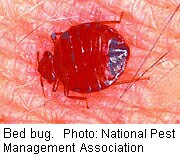- Navigating Your Midlife Crisis: Embracing New Possibilities
- City Raccoons Showing Signs of Domestication
- Mapping the Exposome: Science Broadens Focus to Environmental Disease Triggers
- One Week Less on Social Media Linked to Better Mental Health
- Your Brain Changes in Stages as You Age, Study Finds
- Some Suicide Victims Show No Typical Warning Signs, Study Finds
- ByHeart Formula Faces Lawsuits After Babies Sickened With Botulism
- Switch to Vegan Diet Could Cut Your Greenhouse Gas Emissions in Half
- Regular Bedtime Does Wonders for Blood Pressure
- Dining Alone Could Mean Worse Nutrition for Seniors
Bedbugs’ Genes May Protect Them From Insecticides


MONDAY, Sept. 9Bedbugs — tiny, flat parasites that hide where people sleep — are notoriously tough to kill, but scientists say they think they’ve uncovered new clues about why these bloodsuckers are so hardy.
It seems that bedbugs have genes that disarm pesticides. Most of the genes are active in the bugs’ outer shells, or cuticles. Some work to pump poisons away, before they can enter the insect’s bodies. Others genes break the chemicals’ molecular bonds, rendering them harmless.
Scientists at the University of Kentucky discovered the genes by surveying the entire genomes of 21 different bedbug populations from cities around the Midwest. It took four years to complete the study.
They found 14 genes that work in various combinations to thwart poisons called pyrethroids, the chemicals that have been the first-line agents against bedbug infestations.
When they blocked those genes, the bedbugs once again became susceptible to pyrethroid insecticides.
So far, bedbugs are the only insects that have been found to have these kinds of defenses in their outer cuticle. Other insects, which feed on plant material, develop defenses to toxins in their guts.
That makes a kind of beautiful sense, said study co-author Subba Palli, who is a professor of entomology at the University of Kentucky, in Lexington.
“Bedbugs feed on blood from humans. The only way they’re really exposed to insecticides is when we spray them on their bodies or if they walk on the insecticides. That’s the reason they may have developed a different way of defending themselves,” he said.
Blocking these special genetic defenses in the lab is a relatively straightforward process. Scientists just inject the bugs with strands of RNA that interfere with gene expression. It’s not possible to inject RNA into wild bedbugs, of course.
“One big problem is how do we deliver them to the insect? If someone solves that, I think we could have a really good product,” to kill bedbugs, Palli said.
The research was published earlier this year in the journal Scientific Reports. It will also be presented Monday at the American Chemical Society annual meeting, in Indianapolis.
“I think the work is very interesting, and I think it’s at the forefront of bedbug research,” said Mark Feldlaufer, an entomologist with the USDA’s Agricultural Research Service, in Beltsville, Md.
“They come out at night. They only take five to eight minutes to feed and then they go back to cracks and crevices where they aggregate. Those cracks and crevices might be in your mattress or headboard or things like that,” Feldlaufer said. “So when you apply an insecticide, it’s tough to get it to where they are.”
Hitting them where they live is one problem, said Feldlaufer, who studies bedbugs but is not part of the new research.
“If they’re resistant to many of the chemicals that are used, that’s another problem,” he added.
So what can a bedbug-wary homeowner do? In an American Chemical Society news release, lead study author Fang Zhu of Washington State University recommended common sense measures such as removing bedroom clutter, frequent vacuuming, washing bed linens in hot water and heating them in a dryer, and sealing cracks and crevices.
More information
For more about bedbugs, visit the U.S. Centers for Disease Control and Prevention.
Source: HealthDay
Copyright © 2025 HealthDay. All rights reserved.










